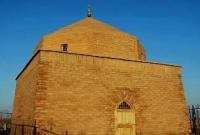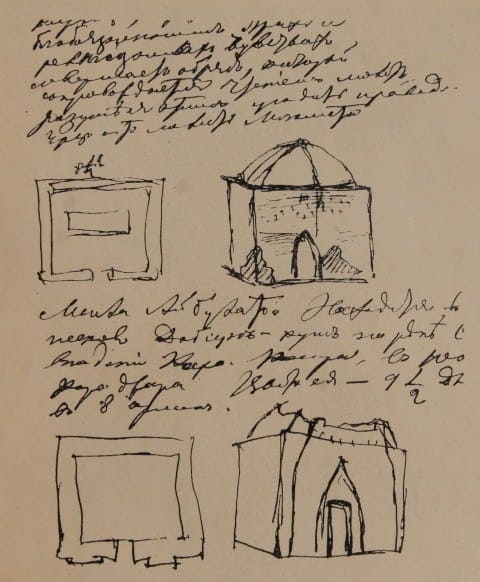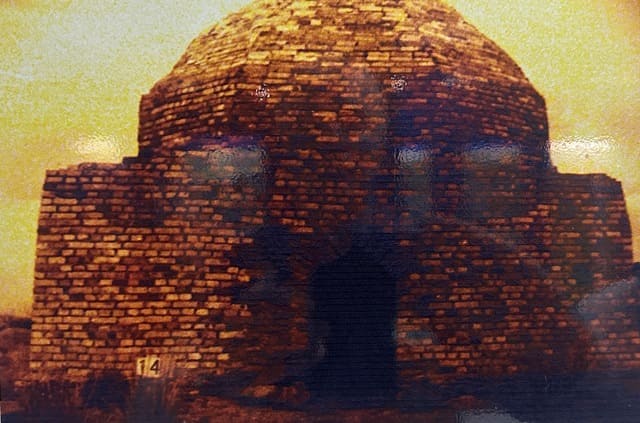Вы здесь
Zhuban Ana mausoleum.

Monuments of Karaganda region.
“That was the day the ancient songs of blood and war spilled from a hole in the sky
And there was a long moment as we listened and fell silent in our grief and then one by one, we stood tall and came together and began to sing of life and love and all that is good and true
And I will never forget that day when the ancient songs died because there was no one in the world to sing them”
Brian Andreas.
Historical sights of Karaganda region.
The mausoleum of Zhuban Ana dates back to the XIh - XIIh centuries, is located at an altitude of 414 meters above sea level, located 2 kilometers north of the 189th crossing and 12.5 kilometers west of the Monadyr station, on the right bank of the Sarysu River in the Zhanarkinsky district in Ulytau region.
The first written information about the Zhuban-an mausoleum was given in 1762 by P. I. Rychkov in the “Printing House of the Orenburg Province”. In 1863, a report about the monument with a drawing and plan was made by Ch. Ch. Valikhanov, who wrote that the grave of Zhuban-an was revered by the Kazakhs as the tomb of an aulie (saint).
In 1946, the mausoleum was examined by the Central Kazakhstan Archaeological Expedition of the Academy of Sciences of the Kazakh SSR (A.Kh. Margulan). In 1974, measurements and photographs of the monument were taken by an expedition of the Ministry of Culture of the Kazakh SSR (M.A. Mamanbaev, M.K. Sembin, M.S. Nurkabaev).
Currently, the Zhuban-Ana mausoleum is included in the list of historical and cultural monuments of state republican significance. At different times there were reports about the mausoleum of P. I. Rychkov (1772), S. Bronevsky (1830), A. I. Levshin (1830), N. Krasovsky (1868), I. Castanye (1910), in Soviet times - Academician of the Academy of Sciences of the Kazakh SSR A. Kh. Margulan, who came to the conclusion that the Zhuban-an mausoleum was a medieval building of the Kipchaks.
The mausoleum is a dome-centric single-chamber structure with internal hemispherical and external hipped domes. The lower volume (of a cubic building) is made of stone slabs and lined with burnt brick, and plastered on the inside with alabaster mortar.
The dome and drum are made of square baked bricks. The transition from the quadrangle to the octagon was carried out by installing arched sails in the corners of the building, and from the octagon to the 16-sided structure and further to the circle of the dome - with the help of brick consoles.
Burnt bricks begin to be used inside the building from the level of the heels of the arched sails. The hemispherical dome was laid using the false vault method. The main volume, slightly expanding at the bottom, carries a low 8-sided drum, topped with an 8-sided tent dome.
The arch of the entrance opening is pointed. The dimensions of the building along the external perimeter are 6 × 6 meters, along the internal perimeter 4 × 4 meters, height 6 meters. The foundation is made of stone slabs approximately 50 centimeters high.
During construction, bricks measuring 27 × 27 × 6 centimeters were used. The transition from the quadrangle to the octagon was carried out using arched sails in the corners of the building, and from the octagon to the 16-sided structure and further to the circle of the dome - using brick consoles.
All masonry was carried out using a special clay mortar; the secret of its production has been lost, but it was a very reliable material; suffice it to say that, despite difficult weather conditions, the masonry has been perfectly preserved to this day.
The entrance to the mausoleum is designed in the form of a pointed arch and is oriented to the southeast. The main supporting structures of the monument are made of burnt and adobe bricks and have a three-layer system.
The architecture of the Zhuban-Ana mausoleum is unique, since when creating it, an unknown master used complex design solutions that required absolutely accurate engineering calculations. The foundation is made of stone slabs about 50 cm high, and the inside is carefully plastered with alabaster mortar.
During the construction of the mausoleum, bricks measuring 27 x 27 x 6 cm were used; it should be noted that all bricks have an almost ideal geometric shape and uniform size. This indicates a fairly developed culture of production of building materials at that time.
In 1982, the mausoleum was included in the list of historical and cultural monuments of the Kazakh SSR of republican significance and was taken under state protection.
Legend of Zhuban Ana mausoleum.
Since the Middle Ages, the mausoleum has been revered as "auliye mola". According to legend, in the era of the Altyn Horde, Talmas-ata lived along the Sarysu River, he had a Zhelmai camel. For the night he stayed at Zhuban-ana, then along the Sarysu river he stopped at Bolgan-ana, Belgen-ana.
Zhelmaya galloped like the wind across the sand of Zhetykonyr, stopping at the holy places. Here travelers spent the night, women made pilgrimages. These four historic mausoleums are located along the Sarysu River.
In 1982, the mausoleum was included in the list of historical and cultural monuments of the Kazakh SSR of republican significance and taken under state protection.
Geographic coordinates of mausoleum of Zhuban ana: N48 ° 33'46.37 "E70 ° 27'06.48".


Authority and photo:
https://ruh.kz/geo/karaganda/mavzolei_zhubanana/
National Encyclopedia of Kazakhstan, Volume 2.







